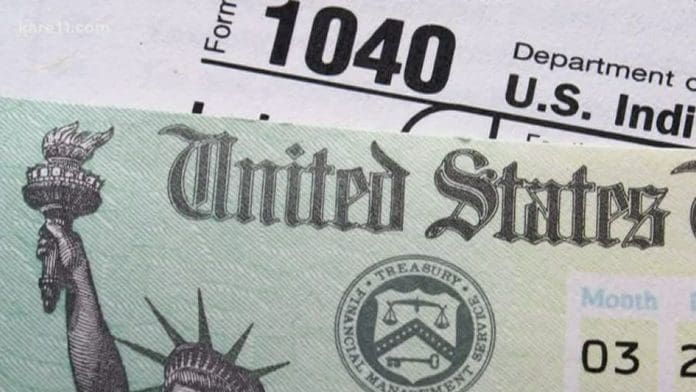Even as the last of the stimulus checks issued under the American Rescue Plan Act went out to residents, America came face-to-face with another economic downturn. This time it was an indirect fallout of the pandemic and the situation further worsened with the intensification of the war in Europe.
Close to one trillion dollars went out in federal relief to US households through the three rounds of stimulus checks starting with the $1,200 payment immediately after a total lockdown was declared on March 15, 2020. The nation began to shut down to prevent the further spread of COVID-19.
The stimulus checks are credited with reducing poverty and ensuring that people did not have to default on their payments or have to go homeless during the pandemic.
The three rounds of stimulus checks were followed by the extended unemployment funds which helped the jobless survive the bitter months of the pandemic with unemployment figures rising to 14.6%. The last stimulus check with direct support from the federal government was the enhanced Child Tax Credit stimulus check which started with 6 monthly checks between July and December 2021, distributing 50% of the total amount.
The balance amount was paid when the 2021 income tax returns were filed this year. But most households have spent their stimulus check and another support amount. The inflation also began to creep up after the third quarter in 2021, which further turned the economic situation grimmer. By the first quarter of 2022, inflation figures have climbed to a 4 decade high and have crept past the 9% mark to remain at 9.11% in June 2022.
States Move In As Federal Stimulus Checks Come To A Halt
A handful of states stepped in at this stage to help out residents as the record inflation threatened to drag down the economy back to the state it was in the initial months of the pandemic.
The states, a little more than a dozen, have relief on their trade surplus for 2021, and federal funds from the APRA are sent to help out pandemic-affected residents, businesses, and other organizations.
The 18 odd states sending out the stimulus checks are giving stimulus checks in various amounts and while most are giving out direct checks, some have opted instead to give income tax rebates.
California and Florida are two of the latest states to propose sending out stimulus checks, though the two states vary in their coverage and the amount it will finally distribute among residents.
But it has a common aim and purpose. The stimulus checks will provide households with much-needed relief. The funds are expected to offset the impact of soaring prices across state economies. With inflation at a 41-year-high, Americans are feeling the effect of inflation that threatens to breach double-digit figures.
Most state governors have realized that the best way to douse this flame of discontent would be to send direct cash to residents immediately. While there is a nagging suspicion that the federal stimulus checks were in part responsible for the high inflation, they also know that at this moment giving out direct payments is the only solution to the problem.
States Have The Funds To Be Generous With Their Stimulus Checks
And states have the economic backup to be generous. California, for instance, is sitting on a cash surplus of $87 billion and is passing a bill to give back a quarter of the total, around $23 billion.
While conservative politicians and economists have sounded the alarm and said that these funds could tip the economy which is already overheated, other policy analysts like Garrett Watson argue that there is not much chance of the stimulus check payments exacerbating inflation further. But they also concede that plain old cash may not be the best way to provide support and ease the strain on people’s wallets.
Across the nation, it is unlikely that it will contribute to inflation, largely because too few states are involved in this exercise. Around a third of the states have agreed to send stimulus checks for their residents.
California Among Latest Among States To Join The List Of States Sending Stimulus Checks
California has finally confirmed that it will be sending out stimulus checks to its residents, the third round for the state which has already sent out the Golden State Stimulus I and II. It has deviated from its initial plan to give gas cards to residents who own vehicles registered in the state. the $400 stimulus checks were limited to two cards per family. Families who did not own vehicles were to be given transit cards to enable free rides on public transport systems.
But Governor Gavin Newsom has changed the plan and has gone for direct stimulus checks to residents. The bill was passed during the election-year bill and legislators authorized the payments with no opposition. The Governor has signed it as part of the budget. The payments are divided into three income segments with the lowest being $75,000.
To be eligible for the refund, residents must have filed their 2020 state income tax return by October 15, 2021. For people who have applied for an Individual Taxpayer Identification Number, the date has been extended to February 15, 2022.
Residents must also meet income eligibility and must have been a resident of California for at least 6 months in 2020. They should also be a resident of California on the date the stimulus check is issued. And finally, they must not have been eligible to be claimed as a dependent on another tax filer’s tax return for 2020.
The final amount of the California state stimulus check will be decided on the adjusted gross income reported by a resident on their 2020 income tax return.
The refund will be a single amount if there are no dependents. The amount has been divided into three slabs with the highest stimulus check for people earning $75,000 or less. They will receive a maximum of $1,050 for three or more members. The next slab is between $75,001 and $125,000 and will come to a maximum of $750. The third slab is between the income of $150,001 and $250,000 and could give a resident a maximum of $600 with a dependent.






